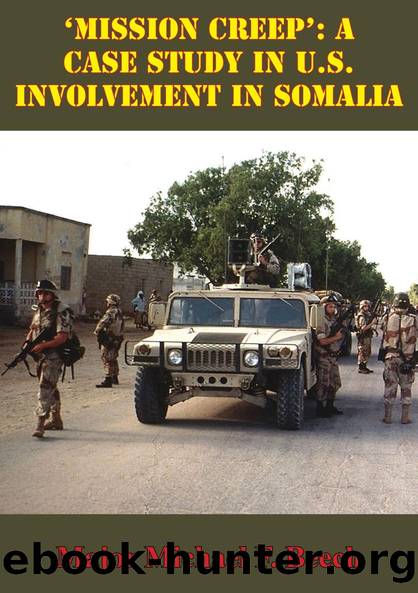'Mission Creep': A Case Study In U.S. Involvement In Somalia by Major Michael F. Beech

Author:Major Michael F. Beech [Beech, Major Michael F.]
Language: eng
Format: epub
Tags: History, Military, Iraq War (2003-2011), Persian Gulf War (1991), United States, Aviation
ISBN: 9781782895169
Google: UhFwCwAAQBAJ
Publisher: Pickle Partners Publishing
Published: 2014-08-15T05:02:32+00:00
V. Conclusions
What started as a mission to feed starving civilians ended in a failed attack on a Somalia warlord. The Bush administration had stated the US intervention in Somalia with established objectives which were clearly defined and limited: feed the people and get out. These objectives, as General Hoar put it, were âdoable.â However, the Clinton administration over time evolved a contradictory and ambiguous policy toward Somalia. Initially Clinton committed only a small US force to UNOSOM II. The decision to keep US forces was more political than military as it was seen as the only way to show US support for the UN mission. Intended to act as a reaction force to help the UN, the small 1200 man US QRF was only to respond in the event of an emergency. However, the Clinton administration eventually changed its policy to mirror the broad objectives envisioned in the UN nation building mandate encapsulated in UN Resolution 814 and later 837. Although the mandatesâ objectives were clearly political in nature, calling for the political reconciliation and rehabilitation of the government, the US and UN operations in Somalia surprisingly lacked political military coordination at the strategic level.
The political diplomatic momentum gained during Restore Hope did not continue during UNOSOM II. Neither the UN nor the US continued the sort of close military-diplomatic cooperation during UNOSOM n that had been achieved in Restore Hope. In August and September Albright and Christopher were unable to get the UN to restart diplomatic initiatives with the SNA and were unwilling to usurp the UNâs authority by pursuing separate US lead negotiations directly with Aideed. Even more surprising was that General Powell, the senior military advisor to the President, was apparently uniformed that the administration was now trying to seek a political solution in Somalia. Furthermore, the Secretary of Defense was continuing to emphasize military operations in August and September as evidenced by his speech at the National Strategic Studies Institute while the Department of State was trying to restart a diplomatic settlement.{175} The political and military efforts were at best uncoordinated. Clintonâs policy was also contradictory.
Clintonâs policy was to keep the US presence small while at the same time he directed that the UN mission must not fail. As a result, US military operations in Somalia expanded to fulfilling UN objectives. Due to the political and diplomatic atrophy existing in Somalia the UN and US tried to achieve the nation building objectives by purely military means. After the June ambush of the Pakistanis both the UN and US objectives degenerated into a manhunt for Aideed and disarmament within Mogadishu. Yet, both Hoar and Powell had previously advised against such a course even with the much larger and more capable UNITAF force. In sum, the Clinton objectives were unattainable given the small force and lack of political diplomatic operations.
Even with the deployment of TF Ranger the senior military leadership was doubtful of success. However, even if TF Ranger had accomplished its mission, it is unlikely that this
Download
This site does not store any files on its server. We only index and link to content provided by other sites. Please contact the content providers to delete copyright contents if any and email us, we'll remove relevant links or contents immediately.
| Civil War | Operation Desert Storm |
| Veterans | Vietnam War |
The Radium Girls by Kate Moore(11971)
100 Deadly Skills by Clint Emerson(4879)
Rise and Kill First by Ronen Bergman(4739)
The Templars by Dan Jones(4656)
The Doomsday Machine by Daniel Ellsberg(4449)
The Rape of Nanking by Iris Chang(4165)
Killing England by Bill O'Reilly(3968)
Hitler in Los Angeles by Steven J. Ross(3923)
Stalin by Stephen Kotkin(3918)
12 Strong by Doug Stanton(3527)
Hitler's Monsters by Eric Kurlander(3291)
Blood and Sand by Alex Von Tunzelmann(3164)
The Code Book by Simon Singh(3137)
Darkest Hour by Anthony McCarten(3096)
The Art of War Visualized by Jessica Hagy(2973)
Hitler's Flying Saucers: A Guide to German Flying Discs of the Second World War by Stevens Henry(2731)
Babylon's Ark by Lawrence Anthony(2648)
The Second World Wars by Victor Davis Hanson(2502)
Tobruk by Peter Fitzsimons(2479)
